Personal Siren Projects
Federal Thuderbolt 1003 From Sherman, Texas
| Warning Sirens Main Page | Sherman, Thunderbolt 1003 | Arkansas, Thunderbolt 1003 | Fort Worth, Thunderbolt 1000 "Bar Grille" |
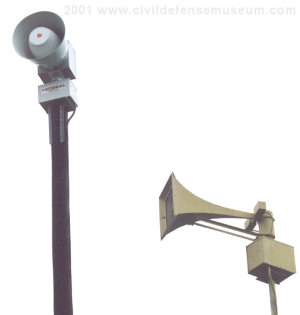
|
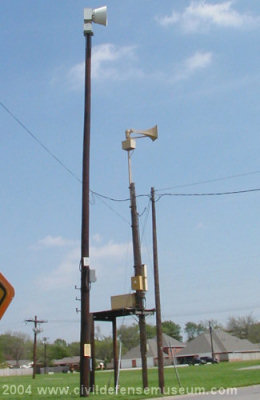
|
The photo on the left above is the first photo I took of the Thunderbolt 1003 in Sherman back
in 2000 or 2001. The Federal 2001 siren on the left in the photo was brand
new at the time. The photo on the right above was taken around 2003.
Click photos to see larger.
I first spotted this Thunderbolt 1003 siren in Sherman back in 2000. I was driving around Sherman with a friend looking for mid-century modern buildings when I noticed a Thunderbolt behind the Westwood Village shopping center. I was pretty surprised when I noticed it was a Thunderbolt 1003 because I had never seen a 1003 anywhere in Texas before. The city of Sherman had just installed a new siren system and had removed all their old sirens except this one and a 2T22 a few miles to the west of this location. I never found out why this 1003 was left in place.
Soon after that I contacted Sherman Emergency Management during one of my quests for old Civil Defense stuff. I didn't ask the EM director about the 1003 at the time. After bugging him a few times after that about old CD stuff he dug up a small pile of Fallout Shelter signs and a few other odds and ends. When I went to pick up the stuff he told me about all the removed sirens being stored at the city service lot. The city of Sherman sold off the other removed sirens at an auction in September 2001 which is another long story I won't get into here. This 1003 remained behind.
Shortly after the Sept. 2001 auction I contacted the city of Sherman about the 1003. I sent them a letter offering to have it removed at no cost to the city if they would give it to me. The city manager told me that they would have to auction it if it was ever removed. Every time I passed through Sherman I would always take a detour by the site to make sure it was still up. It was always there pointing in the same direction with the horn screen gradually deteriorating. It wasn't until 2003 that I bothered the city about it again. I sent them another letter offering to have it removed at no cost to them and the city manager had the same reply. More drive-by checks followed over the years every time I made a trip through Sherman.
Finally, in early 2007 I contacted Sherman Fire Chief Jeff Jones about the 1003 and, after speaking with the Sherman city manager, he called me back in a few days with the idea that the city could loan the 1003 to me permanently. He asked me to send a letter (my 3rd to the City of Sherman) explaining what I intended to do with the siren. I sent a letter explaining that I would most likely restore it and feature it on my on-line Civil Defense Museum site. Chief Jones said that it was OK with the city manager and that I had the go-ahead to take the thing down with the condition that if I ever intend to part with the siren that the city of Sherman be notified and that the siren be returned to them. I agreed and made arrangements with North Texas Signs to have it removed on 10-31-2007. After 7 years it was worth it!
Later on the siren was returned to the city of Sherman. That alone is very long story I won't get into here but the city did put it up for auction on a surplus website. After a short bidding battle I won the siren and it's now my property.
Removing the Thunderbolt 1003 in Sherman Texas.

I contacted North Texas Services to remove the chopper/rotator unit and they arrive at 9:30am 10-31-2007 and setup for the removal. They brought 2 trucks, one was a basket truck and one truck with a crane. They got set-up and right to the job of removing the thing. They said that it was the first siren they had removed. They were a couple of great guys and were fun to deal with.
I was really nervous about finally doing this after trying so long to get this siren. I thought to myself that there were three hurdles to get over in the process of removing the siren. The first hurdle was getting the standpipe bolts loose from the bottom of the siren. This proved to be no problem. The second hurdle was getting the thing taken down without damaging it. That also proved easy thanks to the guys at NTS. They did a great job taking it down. The third hurdle to "jump" was to find out if the siren (chopper) motor was in operating condition. I wouldn't be able to find that out until I got the siren down off of the pole. Thankfully the siren motor fired up immediately the first time I hooked it up! I was really relieved when that weird dual-tone (un-blowered) growl came out of that horn. Click photos to see larger.
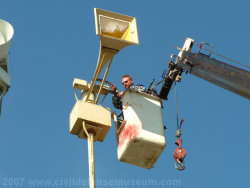
|
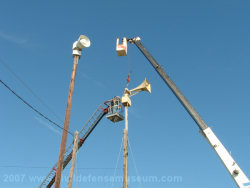
|

|

|
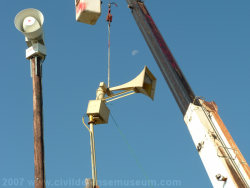
|
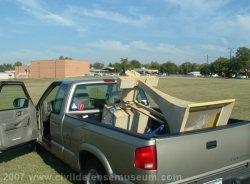
|
Here's a sequential series of photos of the removal from the pole to my truck. I had a really a strange feeling when the horn/rotator plate came loose from that standpipe. I imagined the thing being installed 30+ years ago and how weird it was that I was having the thing taken down so many years later. Thankfully the power service had been removed long ago by the city so that was one major thing I didn't have to deal with in the removal. Click photos to see larger.
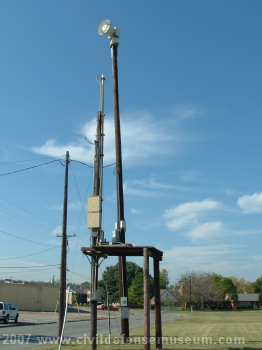
Here's the pole/platform after removing the chopper/rotator. All that remained was the air standpipe, two empty control boxes and the blower frame. The platform and remaining pieces were removed some years later and are no longer there. I didn't think it was worth removing the control boxes because I would have had to pay extra lift time to the NTS guys.
Here's what it looked like when I opened it up.

|

|

|
Here are a few photos of the 1003 chopper/rotator after I got it home. I was
surprised by the condition of the inside of the rotator box. (Left Photo)
The rotator gears still have grease on them and everything in the box was
very clean. The oil spot below the gear box is from oil leaking out of the
gearbox vent when I had the horn tilted down. The hi-lo solenoid collector
ring/brush mechanism is the only thing different about the 1003 rotator
compared to the Thunderbolt 1000/1000T A and C series rotator
and the rotator box is taller to make room for the mechanism.
The hi-lo solenoids were also very clean. (Center Photo) Both move freely
and were in good operating condition. The whole unit assembled in the
garage. (Right Photo) It was fun to be able to check out a different model
of Thunderbolt for a change. It was interesting to check out the differences
between the 1003 and the 1000s I have worked on in the past. As noted above
the rotator box is different to allow for the hi-lo solenoid workings but
the horn is also different. The horn support bolt holes are located further
back on the bottom of the horn compared to the 1000/T models. The differnt
support hole locations allow the
horn to be located further forward due to the solenoid/valve box assembly.
Click Photos To See Larger
Sherman Thunderbolt 1003 Video
See other videos of the Sherman Thunderbolt 1003 on my youtube channel here. http://www.youtube.com/user/vanamonde2
Here is one of the videos I have on youtube.com of the Sherman 1003 operating without a blower. Actually I have a bank drive-thru vacuum blower piped into the blower relief valve when I ran it in the above video. I have a few more videos of the 1003 on youtube. I haven't had the siren chopper motor apart yet but the chopper runs great in the thing! Sure doesn't sound to me like it needs bearings or any work right now.
"CDM/RCM 3" Control Panel
 |
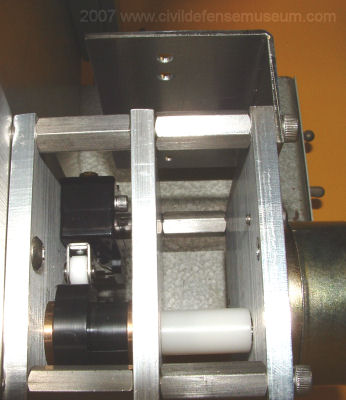 |
The Thunderbolt 1003 uses an extra RCM control panel to operate the Hi-Lo solenoids.
The panel uses what Federal Signal called a "flasher" unit that alternately switches the solenoids to
cause the Hi-Lo signal. This is called a flasher because it's original intended use
was for light circuits in flashing signs.
Since the original RCM3 control panels are very hard to find I built
my own version of a Federal RCM3 control panel to run the hi-lo solenoids.
The photo on the left above shows the panel just after I finished it. I used
a leftover RCM1 panel switch panel for the modulator manual switches. I wired my
panel using the Federal RCM3 schematic from the Thunderbolt manual. I decided
to go electromechanical with my own solenoid switcher "flasher" unit. The above right
photo shows my version of the flasher.
The original Federal RCM3 panel
uses an eddy current motor to drive two switches in it's flasher unit.
I didn't think to look on-line for an actual
flasher unit at the time but they are still available from sign supply companies.
I used a 60 rpm clock motor I had with a single microswitch driven by a delrin
cam, I made, attached to the clock motor shaft.
Click Photos To See Larger
Single Phase Blower From Dallas Fire Station 33
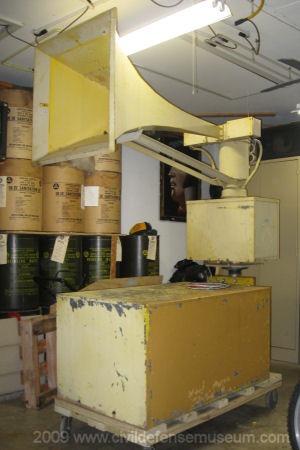
|

|

|
In December 2008 I was able to salvage a single phase blower and RCM panel
from Dallas Fire Station 33 that was scheduled to be demolished. The fire station
was one of the stations built in the late 1940s to early 1950s and still had
one of the first Thunderbolt sirens installed in Dallas in 1959. I removed
the blower and RCM two days before the station was demolished and wanted to
also salvage the chopper/rotator unit but due to lack of communication on the
demolition contractors part the chopper/rotator I was unable to get down there when
the pole was pushed over and it was scrapped. I assembled
the single phase blower and the 1003 chopper/rotator in the same arrangement
as the first Thunderbolt I restored so it can be moved around the garage.
This old style single phase blower uses a 240 volt 7.5 Hp repulsion induction motor
that runs at 3000+ rpm. Since the single phase blower motor runs twice as fast as the 3 phase
blower motor the blower itself is half the size of the 3 phase blower which results
in the same volume of air output.
Click Photos To See Larger
As of late 2017 there are plans for this siren to go back into service in Upson County Geogia eventually. Better for it to go back into service that sit in my garage for 10 more years!